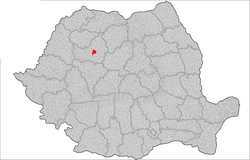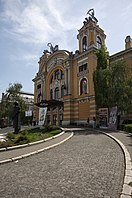Cluj Napoca
| Cluj-Napoca | |||||||
|---|---|---|---|---|---|---|---|
| City | |||||||
From left: St. Michael's Church • Romanian National Opera • Tailors' Bastion • Mihai Viteazul Square • Cluj Arena
|
|||||||
| Nickname(s): Treasure City (Romanian: orașul comoară;Hungarian: kincses város) |
|||||||
 Location of Cluj-Napoca |
|||||||
| Coordinates: 46°46′N 23°35′E / 46.767°N 23.583°E | |||||||
| Country |
|
||||||
| County |
|
||||||
| Metropolitan area | Cluj-Napoca metropolitan area | ||||||
| Status | County capital | ||||||
| Founded | 1213 (first official record as Clus) | ||||||
| Government | |||||||
| • Mayor | Emil Boc (PNL) | ||||||
| • Deputy Mayor | Gheorghe Șurubaru (PNL) | ||||||
| • Deputy Mayor | Anna Horváth (UDMR) | ||||||
| Area | |||||||
| • City | 179.5 km2 (69.3 sq mi) | ||||||
| • Metro | 1,537.5 km2 (593.6 sq mi) | ||||||
| Elevation | 340 m (1,120 ft) | ||||||
| Population (2011 census) | |||||||
| • City | 324,576 | ||||||
| • Density | 1,808/km2 (4,680/sq mi) | ||||||
| • Metro | 411,379 | ||||||
| Time zone | EET (UTC+2) | ||||||
| • Summer (DST) | EEST (UTC+3) | ||||||
| Postal Code | 400xyz1 | ||||||
| Area code(s) | +40 x642 | ||||||
| Car Plates | CJ-N3 | ||||||
| Website | primariaclujnapoca |
||||||
|
1x, y, and z are digits that indicate the street, part of the street, or even the building of the address 2x is a digit indicating the operator: 2 for the former national operator, Romtelecom, and 3 for the other ground telephone networks 3used just on the plates of vehicles that operate only within the city limits (such as trolley buses, trams, utility vehicles, ATVs, etc.) |
|||||||
Coordinates: 46°46′N 23°35′E / 46.767°N 23.583°E
Cluj-Napoca (Romanian pronunciation: [ˈkluʒ naˈpoka]), commonly known as Cluj, is the second most populous city in Romania, after the national capital Bucharest, and the seat of Cluj County in the northwestern part of the country. Geographically, it is roughly equidistant from Bucharest (324 kilometres (201 miles)), Budapest (351 km (218 mi)) and Belgrade (322 km (200 mi)). Located in the Someșul Mic River valley, the city is considered the unofficial capital to the historical province of Transylvania. From 1790 to 1848 and from 1861 to 1867, it was the official capital of the Grand Principality of Transylvania. Other names for the city include: German: Klausenburg; Hungarian: Kolozsvár, Hungarian pronunciation: [ˈkoloʒvaːr]; Medieval Latin: Castrum Clus, Claudiopolis; and Yiddish: קלויזנבורג, Kloiznburg.
...
Wikipedia





